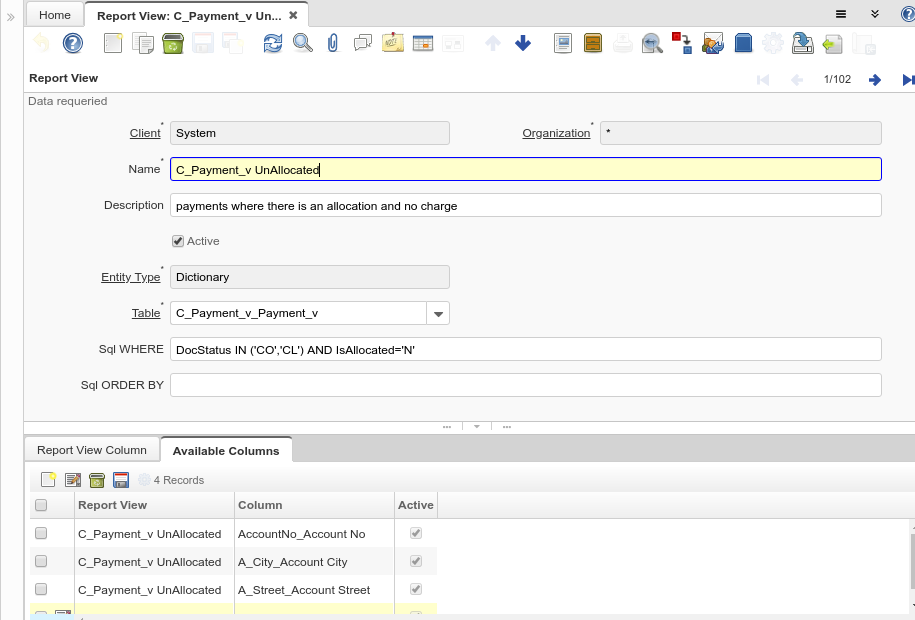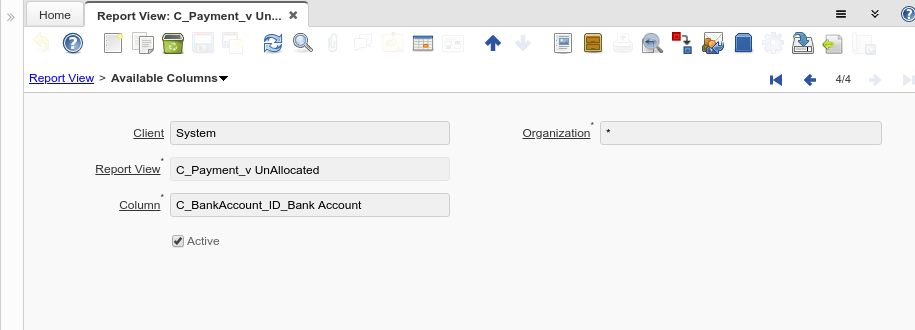Report View (Window ID-180)
Window: Report View
Description: Maintain Report Views
Help: The Report View Window defines the views used when generating reports. This window is for System Admin use only.
Tab: Report View
Description: Define Report View
Help: The Define Report View defines the views used in report generation
| Name | Description | Help | Technical Data |
|---|---|---|---|
| Tenant | Tenant for this installation. | A Tenant is a company or a legal entity. You cannot share data between Tenants. | AD_ReportView.AD_Client_ID numeric(10) Table Direct |
| Organization | Organizational entity within tenant | An organization is a unit of your tenant or legal entity - examples are store, department. You can share data between organizations. | AD_ReportView.AD_Org_ID numeric(10) Table Direct |
| Name | Alphanumeric identifier of the entity | The name of an entity (record) is used as an default search option in addition to the search key. The name is up to 60 characters in length. | AD_ReportView.Name character varying(60) String |
| Description | Optional short description of the record | A description is limited to 255 characters. | AD_ReportView.Description character varying(255) String |
| Active | The record is active in the system | There are two methods of making records unavailable in the system: One is to delete the record, the other is to de-activate the record. A de-activated record is not available for selection, but available for reports.
There are two reasons for de-activating and not deleting records: (1) The system requires the record for audit purposes. (2) The record is referenced by other records. E.g., you cannot delete a Business Partner, if there are invoices for this partner record existing. You de-activate the Business Partner and prevent that this record is used for future entries. |
AD_ReportView.IsActive character(1) Yes-No |
| Entity Type | Dictionary Entity Type; Determines ownership and synchronization | The Entity Types "Dictionary", "iDempiere" and "Application" might be automatically synchronized and customizations deleted or overwritten.
For customizations, copy the entity and select "User"! |
AD_ReportView.EntityType character varying(40) Table |
| Table | Database Table information | The Database Table provides the information of the table definition | AD_ReportView.AD_Table_ID numeric(10) Table Direct |
| Sql WHERE | Fully qualified SQL WHERE clause | The Where Clause indicates the SQL WHERE clause to use for record selection. The WHERE clause is added to the query. Fully qualified means "tablename.columnname". | AD_ReportView.WhereClause character varying(2000) String |
| Sql ORDER BY | Fully qualified ORDER BY clause | The ORDER BY Clause indicates the SQL ORDER BY clause to use for record selection | AD_ReportView.OrderByClause character varying(2000) String |
Tab: Report View Column
Description: Report View Column
Help: The Report View Column Tab defines any columns which will be overridden in the generation of the select SQL
| Name | Description | Help | Technical Data |
|---|---|---|---|
| Tenant | Tenant for this installation. | A Tenant is a company or a legal entity. You cannot share data between Tenants. | AD_ReportView_Col.AD_Client_ID numeric(10) Table Direct |
| Organization | Organizational entity within tenant | An organization is a unit of your tenant or legal entity - examples are store, department. You can share data between organizations. | AD_ReportView_Col.AD_Org_ID numeric(10) Table Direct |
| Report View | View used to generate this report | The Report View indicates the view used to generate this report. | AD_ReportView_Col.AD_ReportView_ID numeric(10) Table Direct |
| Column | Column in the table | Link to the database column of the table | AD_ReportView_Col.AD_Column_ID numeric(10) Table Direct |
| Active | The record is active in the system | There are two methods of making records unavailable in the system: One is to delete the record, the other is to de-activate the record. A de-activated record is not available for selection, but available for reports.
There are two reasons for de-activating and not deleting records: (1) The system requires the record for audit purposes. (2) The record is referenced by other records. E.g., you cannot delete a Business Partner, if there are invoices for this partner record existing. You de-activate the Business Partner and prevent that this record is used for future entries. |
AD_ReportView_Col.IsActive character(1) Yes-No |
| Function Column | Overwrite Column with Function | The Function Column indicates that the column will be overridden with a function | AD_ReportView_Col.FunctionColumn character varying(124) String |
| SQL Group Function | This function will generate a Group By Clause | The SQL Group Function checkbox indicates that this function will generate a Group by Clause in the resulting SQL. | AD_ReportView_Col.IsGroupFunction character(1) Yes-No |
Tab: Available Columns
Description: You can define on this tab which columns will be available as the print format items
Help:
| Name | Description | Help | Technical Data |
|---|---|---|---|
| Tenant | Tenant for this installation. | A Tenant is a company or a legal entity. You cannot share data between Tenants. | AD_ReportView_Column.AD_Client_ID numeric(10) Table Direct |
| Organization | Organizational entity within tenant | An organization is a unit of your tenant or legal entity - examples are store, department. You can share data between organizations. | AD_ReportView_Column.AD_Org_ID numeric(10) Table Direct |
| Report View | View used to generate this report | The Report View indicates the view used to generate this report. | AD_ReportView_Column.AD_ReportView_ID numeric(10) Search |
| Column | Column in the table | Link to the database column of the table | AD_ReportView_Column.AD_Column_ID numeric(10) Table Direct |
| Active | The record is active in the system | There are two methods of making records unavailable in the system: One is to delete the record, the other is to de-activate the record. A de-activated record is not available for selection, but available for reports.
There are two reasons for de-activating and not deleting records: (1) The system requires the record for audit purposes. (2) The record is referenced by other records. E.g., you cannot delete a Business Partner, if there are invoices for this partner record existing. You de-activate the Business Partner and prevent that this record is used for future entries. |
AD_ReportView_Column.IsActive character(1) Yes-No |
Contributions / Posts
See documentation at Report View



